| AUGUST 2023 |
|
6 shows in T˘ky˘ (Kabukiza, National Theatre, Asakusa K˘kaid˘), 1 in Ky˘to (Minamiza), 2 in ďsaka (National Bunraku Theatre, Kintetsu Art Kan), 1 in Saitama (Rai BoC Hall) and 1 tour (Western Provinces)!
|
| Kabukiza (T˘ky˘) |  |
| Dates | 5 ~ 27 August 2023 Hachigatsu N˘ry˘ Kabuki August Cool-Breeze Kabuki |
| 1st program |
Hadaka D˘chű |
| 2nd program |
Shinmon Tatsugor˘ |
| 3rd program |
Shin Suikoden |
| Casting |
Nakamura Kankur˘, Nakamura Shichinosuke, Matsumoto K˘shir˘, Nakamura Senjaku, Nakamura Shid˘, Nakamura Karoku, Band˘ Yajűr˘, Ichikawa Chűsha, Nakamura Hayato, Band˘ Minosuke, Nakamura Kazutar˘, Nakamura Kotar˘, Kataoka Kamez˘, Ichikawa Komaz˘, Ichikawa Monnosuke, Ichikawa Emisabur˘, Ichikawa Emiya, Ichikawa En'ya, Ichikawa Omez˘, Matsumoto Kingo, Sawamura S˘nosuke, Band˘ Shingo, ďtani Hirotar˘, Nakamura Hashinosuke, Nakamura Fukunosuke, Nakamura Utanosuke, Nakamura Toranosuke, Ichikawa Somegor˘, Ichikawa Juen, Ichikawa Seiko, Nakamura Baika, Nakamura Kichinoj˘, Ichimura Hikaru, Ichikawa Danko, Nakamura Kantar˘, Asano Kazuyuki, Kashima Noritoshi |
| Comments |
The August Young Actors Kabuki performances at the Kabukiza.
|
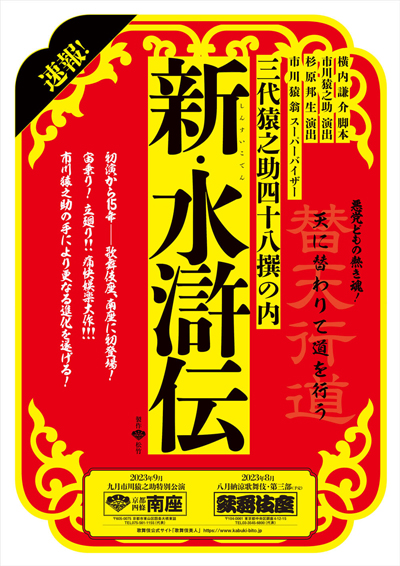 |
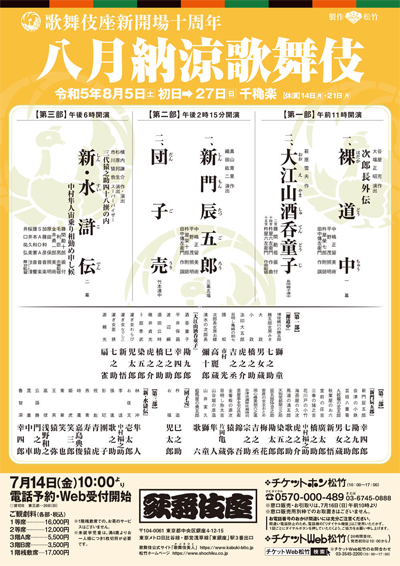 |
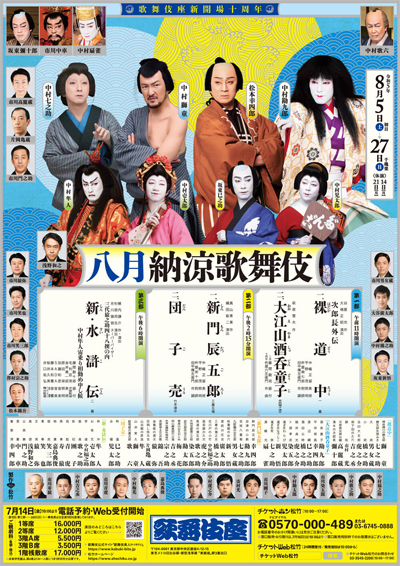 |
|
|||
| Dates | 3 ~ 27 August 2023 Band˘ Tamasabur˘ Tokubetsu K˘en Band˘ Tamasabur˘ Special Performances |
||
| Program | |||
| Casting |
Living National Treasure Band˘ Tamasabur˘, Kataoka Ainosuke, Kamimura Kichiya, Nakamura Kamenoj˘, Kitamura Rokur˘, Kawai Yukinoj˘ |
||
| Comments |
A special program starring the amazing Living National Treasure onnagata Band˘ Tamasabur˘ in Ky˘to at the Minamiza. The guest star is Kataoka Ainosuke.
|
||
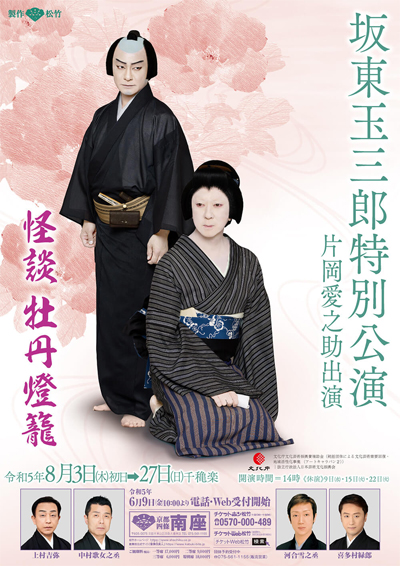 |
| National Theatre (T˘ky˘) |
| Dates | 5 ~ 6 August 2023 Ne no Kai |
| Program |
Aki no Irokusa |
| Comments |
25th edition of the summer program of the association Ne no Kai (literally 'the Sound Association'). The first 3 items in this program are only musical performances. |
| Dates | 11 ~ 15 August 2023 Chigyokai/Kabukikai |
| Program |
|
| Comments |
29th edition of the common program for 2 associations, the Chigyokai (the Young Fishes Association) and the Kabukikai (the Kabuki Association), which stars stars' disciples in the leading roles of all the items in the program under the supervision of Nakamura Tokiz˘, Ichikawa Danz˘, Ichimura Kitsutar˘ and the furitsuke master Fujima Kanso III. |
|
|||
| Dates | 2 ~ 3 August 2023 Ken no Kai |
||
| Program |
|
||
| Casting |
Onoe Ukon, Nakamura Ganjir˘, Band˘ Minosuke, Nakamura Yonekichi, Nakamura Kangyoku, Nakamura Tanenosuke, Onoe Kikusabur˘ |
||
| Comments |
7th edition of the Ken no Kai, a 2-day 4-performance gala starring Onoe Kikugor˘ VI's great-grandson Onoe Ukon. Ken no Kai literally means 'Ken's Association' with Ken being the first ideogram in Onoe Ukon's real first name Kensuke.
|
||
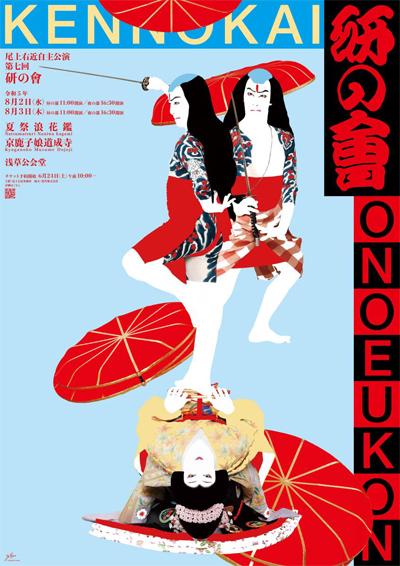 |
|
|||
| Dates | 5 August 2023 Kabuki Buy˘ Tokubetsu K˘en Kabuki Dance Special Performances |
||
| Program | |||
| Casting |
Nakamura Ganjir˘, Nakamura Kinnosuke, Onoe Ukon, Nakamura Yonekichi, Nakamura Takanosuke
|
||
| Comments |
A special 1-day 2-performance Kabuki Buy˘ program in Saitama at the Rai BoC Hall (ďmiya Civic Hall). |
||
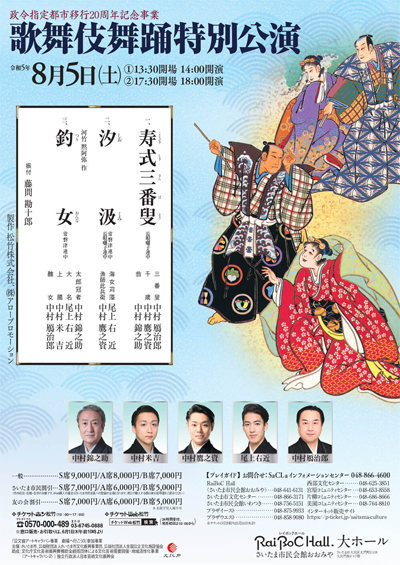 |
|
|||
| Dates | 3 ~ 6 August 2023 Sora no Kai |
||
| Program |
Higo no Komageta |
||
| Casting |
Kataoka Matsujűr˘, Kataoka Senjir˘, Kataoka Senju, Kataoka T˘jűr˘, Nakamura Kansei, Kataoka Yűjir˘, Kataoka Rikiya, Kataoka Toshiya, Kataoka Sentar˘, Kataoka Aijir˘ |
||
| Comments |
The 8th gala of the Sora no Kai (literally 'Sky Society'), in ďsaka at the Kintetsu Art Kan, which stars mostly disciples of the Matsushimaya guild. These performances are entitled Abeno Kabuki (Abeno is the name of a famous district in ďsaka). Two performances each day, one at 12:00 and one at 17:00. |
||
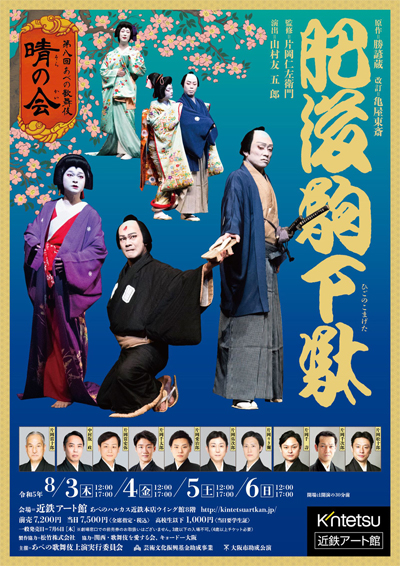 |
| National Bunraku Theatre (ďsaka) |
| Dates | 25 ~ 26 August 2023 Kamigata Kabukikai |
| Program |
|
| Comments |
33rd edition of the Kamigata Kabukikai (the Kamigata Kabuki Association), a summer program in ďsaka which stars Kamigata Kabuki stars' disciples in the leading roles under the supervision of Living National Treasure Kataoka Nizaemon, Kataoka Gat˘, Nakamura Ganjir˘, Kataoka Takatar˘ and Kamimura Kichiya for the 5th and 6th acts of "Kanadehon Chűshingura". The dance-drama "Tsuri Onna" is staged under the supervision of the furitsuke Yamamura Tomogor˘ III. |
| Kabuki Tour in the Western Provinces | |
| Dates | 31 August ~ 24 September 2023 Sh˘chiku ďkabuki Nishi K˘su Sh˘chiku Grand Kabuki Western Course |
| Program | |
| Casting |
Nakamura Ganjir˘, Kamimura Kichiya, Nakamura Kikaku, Nakamura Jűjir˘, Arashi Kitsusabur˘, Kamimura Kichitar˘ |
| Comments |
The Grand Kabuki Tour in the Western Provinces.
|
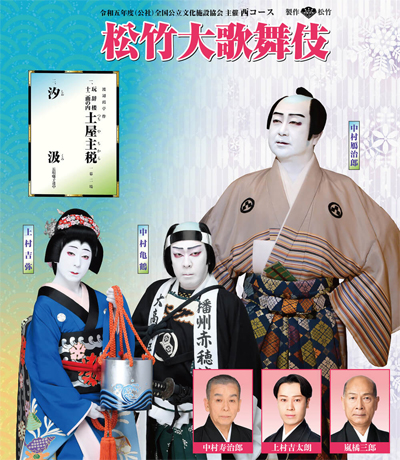 |
|
|
| Contact | Main | Top | Updates | Actors | Plays | Playwrights | Programs | Links | FAQ | Glossary | Chronology | Illustrations | Prints | Characters | Derivatives | Theaters | Coming soon | News |

